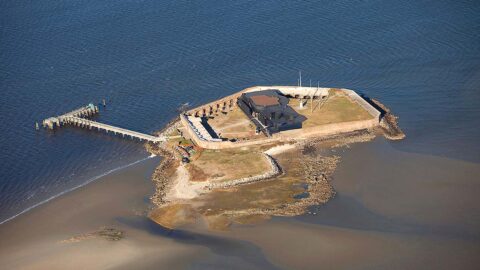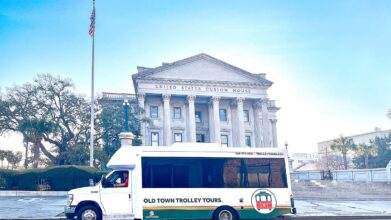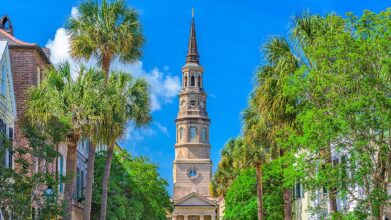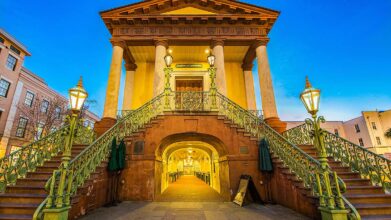Complete Guide to Fort Sumter in Charleston

Fort Sumter, located in Charleston Harbor, South Carolina, is one of the most important landmarks in American history. It was here, on April 12, 1861, that the first shots of the Civil War were fired. Although construction had started decades earlier, Fort Sumter was still incomplete when Confederate forces opened fire on the Union garrison stationed inside. That moment marked the beginning of a long and devastating war that would reshape the nation.
Built on a man-made island near the entrance to the harbor, Fort Sumter was originally intended to strengthen Charleston’s coastal defenses. Once it fell into Confederate hands, the fort became a symbol of southern resistance. It endured nearly constant bombardment from Union forces throughout the war and suffered heavy damage in the process. Despite this, the Confederacy held it until early 1865, when Charleston was evacuated and Union troops reclaimed the site.
Today, Fort Sumter stands as a powerful reminder of the war’s beginnings and the deep divisions that led to it. Visitors can walk among its remains, take in the harbor views, and learn about the events that unfolded on this small but significant piece of land. Accessible only by boat, Fort Sumter offers a unique and moving look into America’s past.
History of Fort Sumter
The history of Fort Sumter is closely tied to the outbreak of the American Civil War. Construction began in 1829, part of a larger effort to improve coastal defenses after the War of 1812. Built on a man-made island at the entrance to Charleston Harbor, the fort was named after General Thomas Sumter, a hero of the American Revolution. Despite decades of effort, Fort Sumter remained incomplete by the time tensions between North and South reached a breaking point.
After South Carolina seceded from the Union in December 1860, the fort quickly became a flash point in the growing conflict. Union Major Robert Anderson moved his small force from Fort Moultrie to Fort Sumter, seeking a more defensible position. This move was seen as a provocation by Confederate leaders, and a standoff began. For months, supplies dwindled as Confederate forces surrounded the harbor, demanding that the Union troops abandon the fort.
On April 12, 1861, after negotiations failed, Confederate artillery opened fire on Fort Sumter. The bombardment lasted 34 hours and ended with Major Anderson’s surrender. Although no soldiers were killed during the exchange, the event marked the official start of the Civil War. Fort Sumter remained in Confederate hands for nearly four years, enduring heavy bombardment by Union forces attempting to retake the harbor.
In February 1865, as Union troops closed in on Charleston, Confederate forces evacuated the city. The Union reoccupied Fort Sumter shortly after, though the fort had suffered severe structural damage by that point. Today, the battered brick walls still stand as a powerful reminder of the war’s beginnings and the deep divisions that led to it. Fort Sumter continues to serve as a historical site where visitors can reflect on one of the most pivotal moments in American history.
Facts About Fort Sumter
- Fort Sumter was named in honor of General Thomas Sumter, a prominent figure in the American Revolution. Known for his relentless fighting style and leadership in the backcountry of South Carolina, he was nicknamed “The Carolina Gamecock.” His legacy lived on not only through the fort’s name but also as inspiration for South Carolina’s state militia and the University of South Carolina mascot.
- The fort sits on a man-made island in the middle of Charleston Harbor, positioned strategically to guard the entrance to one of the South’s most important ports. The island was created by depositing over 70,000 tons of rock and stone onto a submerged sandbar. This engineering feat allowed Fort Sumter to serve as a powerful coastal defense installation, ideally located to control ship access to Charleston.
- Construction on Fort Sumter began in 1829 as part of a national effort to improve harbor defenses following the War of 1812. The U.S. government recognized Charleston’s vulnerability and prioritized the fort’s location for future military readiness. However, construction was slow and plagued by funding delays. By the time tensions between North and South escalated, Fort Sumter remained incomplete and undersupplied.
- When the Civil War began, Fort Sumter was not fully armed or structurally finished, making it far from battle-ready. Its defensive capabilities were limited, with fewer cannons and supplies than originally planned. This left the small Union garrison stationed there at a disadvantage when Confederate forces began their assault in the spring of 1861.
- Fort Sumter became the site of the Civil War’s first battle when Confederate artillery opened fire on April 12, 1861. The Union troops, led by Major Robert Anderson, held out for 34 hours before surrendering. Although no one was killed during the bombardment, this event marked the official start of a long and devastating national conflict.
- Throughout the war, Fort Sumter endured relentless artillery fire, particularly from Union forces trying to retake control of Charleston Harbor. At times, thousands of shells rained down on the fort, causing massive structural damage. Its once-symmetrical brick walls were reduced to jagged ruins, yet Confederate troops continued to occupy and defend it.
- Despite the destruction, Fort Sumter remained a powerful symbol of resistance for the Confederate cause. Even in its damaged state, the fort stood as a reminder of the South’s determination to defend Charleston. Union forces were not able to reclaim the fort until February 1865, when Confederate troops evacuated the city under pressure from advancing Union lines.
- Today, Fort Sumter is preserved as a national monument and operated by the National Park Service. Visitors can explore its crumbling walls, examine Civil War-era artifacts and learn about the events that unfolded there. A visit to Fort Sumter offers a rare opportunity to stand at the site where the Civil War began and to reflect on its lasting impact on American history.
Know Before You Go
- Fort Sumter is accessible only by boat
There are no roads or bridges leading to the fort, which sits on a man-made island at the mouth of the harbor. All visitors must take a ferry, which adds to the experience with sweeping views of Charleston’s skyline and surrounding waterways. The ride itself is part of what makes a visit to Fort Sumter so unique. - Fort Sumter Tours is the only authorized ferry provider
The National Park Service works with Fort Sumter Tours to offer ferry service to and from the island. Boats run daily, and tickets are available online or in person. During peak seasons like spring, summer and holiday weekends, ferries fill up quickly. Booking your tickets in advance is the best way to secure your preferred tour time. - There is no entrance fee to Fort Sumter, but ferry tickets are required
Access to the site is included with your ferry reservation. On-site, National Park Service rangers offer historical interpretation, optional talks, and helpful information as you explore the grounds. The experience is both educational and self-paced, giving visitors time to take in the fort and its surroundings. - Ferries depart from two locations: Liberty Square and Patriots Point
You can choose to depart from Liberty Square in Downtown Charleston or Patriots Point in Mount Pleasant. Both departure points have visitor centers with museum-style exhibits, restrooms and small shops. Liberty Square is also located next to the South Carolina Aquarium, which makes it a convenient place to spend the day. - The full tour experience takes about 2 to 2.5 hours
The boat ride to Fort Sumter lasts approximately 30 minutes each way, and visitors typically have around one hour on the island. During your time at the fort, you can walk through historic areas, explore museum displays, attend a ranger presentation and enjoy scenic views of Charleston Harbor. - Spring and fall offer the best weather for a visit
These seasons bring mild temperatures and more comfortable conditions for outdoor exploration. Summer is popular but can be hot and crowded, so early morning tours are usually better. Winter is generally less busy, though visitors should be prepared for cooler weather and the possibility of wind affecting ferry schedules. - There are limited facilities on the island
There are no food vendors or water fountains at Fort Sumter. Restrooms are located on the ferry boats and at the departure sites, but not inside the fort. Visitors are encouraged to bring water, wear weather-appropriate clothing and choose sturdy shoes, as the walking paths include uneven surfaces. - A visit to Fort Sumter is an opportunity to reflect on American history
Exploring the grounds where the Civil War began offers a powerful perspective on the events that shaped the nation. The combination of preserved ruins, interpretive displays and panoramic harbor views helps visitors connect to the significance of this historic site. First-time visitors and returning guests alike will find something meaningful to take away.
Things To Do on Fort Sumter
Traveling to Fort Sumter by Ferry
The experience begins with a ferry ride through Charleston Harbor. As you travel to Fort Sumter, you’ll enjoy views of the city’s skyline, the Ravenel Bridge, and other waterfront landmarks. Many ferries offer live or recorded narration, providing context about the harbor’s military and maritime history. The journey sets the stage for your visit and gives you a sense of the fort’s strategic location at the harbor’s entrance.
Walking Through the Fort’s Remains
Once you arrive, you can walk through the remains of Fort Sumter and see the effects of the Civil War firsthand. Damaged brick walls, partially collapsed structures and original artillery mounts all reflect the intensity of the bombardments it endured. Interpretive signs throughout the site help visitors imagine what the fort looked like before the shelling. This self-guided walk is one of the most immersive parts of the experience.
Attending Ranger Presentations
Throughout the day, National Park Service rangers offer talks that cover Fort Sumter’s history and its role in the start of the Civil War. These presentations often include personal stories of the soldiers who lived and served there, adding a human element to the site’s military past. Rangers also answer questions and can provide deeper insight into lesser-known aspects of the fort’s timeline.
Examining the Displays and Artifacts
Inside the fort and along designated exhibit areas, you’ll find a collection of Civil War-era artifacts. These include original cannons, fragments of shells and personal items that once belonged to Union and Confederate soldiers. Educational displays explain the significance of each item and how it fits into the broader history of Fort Sumter. The combination of relics and well-curated signage makes this a favorite stop for history lovers.
Observing the Flag Ceremony
During certain tours, visitors may witness the raising or lowering of the American flag at Fort Sumter. This simple yet symbolic moment allows time for reflection on the sacrifices tied to the site. Park staff sometimes involve visitors in the ceremony, especially during morning tours, making it a memorable and meaningful experience.
Viewing the Harbor Scenery
From the fort’s elevated points, you’ll have wide views of Charleston Harbor, the city skyline, and nearby forts such as Fort Moultrie. These panoramic scenes help illustrate Fort Sumter’s defensive positioning and strategic importance. Many visitors take time to sit and absorb the peaceful contrast between the current landscape and the site’s violent past.
Reflecting on the Civil War’s Origins
The grounds of Fort Sumter offer space to consider the events that led to one of the darkest chapters in American history. Standing on the site where the first shots of the Civil War were fired gives visitors a direct and emotional connection to the past. The setting invites quiet reflection on the causes, costs and consequences of the war.
Visiting the Exhibits at the Departure Point Visitor Center
Before or after visiting Fort Sumter, take time to explore the exhibits at the Liberty Square or Patriots Point visitor centers. These indoor displays provide historical background, including a detailed timeline of events leading to the war. You’ll also find Civil War maps, personal accounts, and educational videos. Both centers include park stores where you can purchase books and souvenirs related to Fort Sumter and Charleston’s history.
Nearby Things To Do
Old Town Trolley Tours
Embark on a captivating journey through the heart of Charleston aboard our custom-built vehicles in air-conditioned comfort. Our expert guides bring the city’s vibrant story to life, blending entertainment with education for an unforgettable experience.Discover iconic landmarks, from the historic Battery and Rainbow Row to the poignant history of Fort Sumter. The tour makes two brief stops at Hampton Park and Battery Point where your guide and vehicle will wait for you. Don’t just visit Charleston, relive it with Old Town Trolley Tours.
Patriots Point Naval & Maritime Museum
Located in Mount Pleasant, right next to one of the Fort Sumter ferry departure points, Patriots Point offers a powerful look at American military history. Visitors can explore the USS Yorktown aircraft carrier, board the USS Laffey destroyer and tour a Cold War-era submarine. The museum also includes interactive exhibits focused on the Vietnam War and the Medal of Honor. With its large-scale displays and waterfront views, Patriots Point makes a great companion experience before or after visiting Fort Sumter.
South Carolina Aquarium
Situated beside the Liberty Square ferry terminal, the South Carolina Aquarium is home to more than 5,000 animals representing the ecosystems of South Carolina. Highlights include the two-story Great Ocean Tank, sea turtles undergoing rehabilitation, and engaging touch tanks for younger visitors. Educational talks and animal feedings happen daily. Because of its location just steps from the Fort Sumter visitor center, it’s easy to pair the aquarium and fort into a full day of learning and exploration.
Charleston Harbor Tours
For those looking to take in more of the city’s maritime charm, Charleston Harbor Tours offers a relaxing and informative option. These narrated boat cruises glide past key sites, such as Fort Sumter, Castle Pinckney, The Battery and the Ravenel Bridge. Guides share stories about Charleston’s role in the American Revolution, the Civil War and its rise as a port city. Some tours are even timed around sunset or paired with live music, giving you a new way to appreciate the views and history that surround Fort Sumter.
FAQs
How do I get to Fort Sumter from Charleston?
Fort Sumter is located in Charleston Harbor and is only accessible by boat. You will need to take a ferry operated by Fort Sumter Tours, the official transportation provider. Ferries depart from Liberty Square in Downtown Charleston and Patriots Point in Mount Pleasant.
How much time should I allocate for a visit to Fort Sumter?
The full tour experience takes approximately 2 to 2.5 hours. This includes the round-trip ferry ride and about one hour spent exploring the fort itself.
Why is Fort Sumter in Charleston famous?
Fort Sumter is famous for being the site where the first shots of the American Civil War were fired on April 12, 1861. The bombardment marked the beginning of a four-year conflict between Union and Confederate forces.
Can I visit Fort Sumter without taking a ferry?
No. Fort Sumter is located on an island and cannot be accessed by foot, car or bridge. The only way to visit is by booking a ferry through Fort Sumter Tours.
Is Fort Sumter suitable for children and school groups?
Yes. Fort Sumter is a family-friendly destination and offers educational opportunities for visitors of all ages. Park rangers often tailor their presentations to younger audiences, and the visitor centers include exhibits designed to help children understand the history of the site.
What should I bring when visiting Fort Sumter?
Comfortable walking shoes, sunscreen, water and weather-appropriate clothing are recommended. There are no concessions on the island, so it’s important to bring anything you may need during the one-hour visit.
Are guided tours available at Fort Sumter?
While there are no formal guided walking tours, National Park Service rangers are stationed at the site and offer scheduled presentations throughout the day. These talks provide valuable historical context and are included with your admission.
Is there a visitor center at Fort Sumter?
Fort Sumter itself does not have a traditional visitor center, but both departure locations — Liberty Square and Patriots Point — feature indoor exhibits, historical displays, and park stores. These centers are great places to start or end your visit and offer additional information about Charleston’s role in the Civil War.




